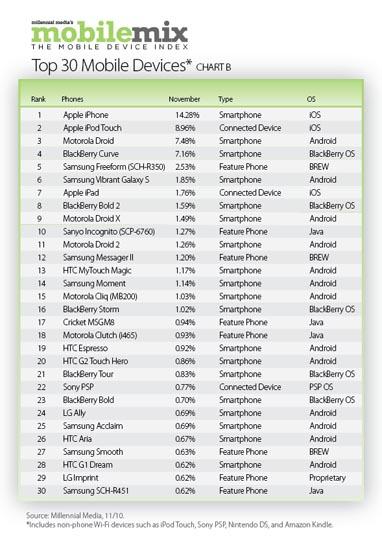
The Android v. iOS war is continuing on as strong as ever, and today Millennial Media put out a new report to show you just how each mobile OS has been faring. As you can see in the graph above, Android and iOS are in a dead heat when it comes to number of ad impressions in November with 38 percent each, and both OSes managed to double RIM's impression percentage. In terms of application platforms, things were a little different, with Android beating out iOS by 15 percent. Smartphones in general continue to gain popularity, but feature phones still make up 29 percent of impressions. Interestingly, connected devices like the Sony PSP and Amazon Kindle took 13 percent of impressions.
The report also breaks down the top mobile devices and manufacturers, and Apple managed to come out on top in both categories. The iPhone climbed to the top of the mobile device heap, claiming 14.28 percent of all ad impressions, while the iPod Touch and Motorola DROID took spots two and three with 8.96 percent and 7.48 percent, respectively. Meanwhile, Apple captured 25 percent of all impressions when it comes to device manufacturers, with Samsung snagging 17.3 percent and Moto taking 15.33 percent.
Finally, a graph showing showing which platforms that publishers plan to support in the next year shows another tight race between Android and iOS. On top is Google's green robot with 29 percent, while iOS is right behind with 28 percent.
While reports like these shouldn't always be taken as gospel (why is there no EVO/Epic?), it certainly makes for interesting conversation. I don't know about you, but I was surprised to see some feature phones, like Samsung's Freeform and Messager II, so high up on the top devices list. Smartphones may be gaining traction with many consumers, but the feature phone still has its place in the world. The war between Android and iOS is pretty close, as usual, and both platforms stand to see quite a bit of growth and popularity with developers in the next year. With upcoming devices like dual-core and 4G Android phones and the Verizon iPhone, it should be interesting to see what these numbers look like in around six months. Any guesses as to what effect those products will have on the market?

Via Millennial Media